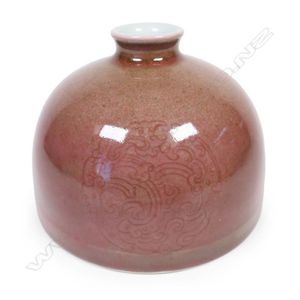A quality Chinese porcelain beehive (taibai zun) form brush…
A quality Chinese porcelain beehive (taibai zun) form brush washer, the peach bloom glaze over fine incised roundel decoration. Underglaze blue Kangxi mark and labels to base, height 9 cm, diameter 12 cm.
You must be a subscriber, and be logged in to view price and dealer details.
Subscribe Now to view actual auction price for this item
When you subscribe, you have the option of setting the currency in which to display prices to $Au, $US, $NZ or Stg.
This item has been sold, and the description, image and price are for reference purposes only.
- Incised - A record of a name, date or inscription, or a decoration scratched into a surface, usually of a glass or ceramic item with a blunt instrument to make a coarse indentation. Compare with engraving where the surface is cut with a sharp instrument such as a metal needle or rotating tool to achieve a fine indentation.
- Peach Bloom - Peach bloom glaze is a type of ceramic glaze that was commonly used in Chinese pottery during the 18th and 19th centuries. It is a type of monochrome glaze that ranges in colour from pale pink to deep red, resembling the colour of a peach blossom.
The glaze is created using a combination of iron oxide and copper oxide, which are mixed together in specific proportions and applied to the ceramic surface. The glaze is then fired in a kiln at a high temperature, which causes the iron and copper oxides to interact and create the characteristic range of colours.
Peach bloom glaze is known for its delicate, translucent quality, which allows the underlying ceramic body to show through in places. It was used to decorate a range of ceramics, from small vases to large bowls and plates. The technique was particularly popular during the Qing Dynasty. - Roundel - A roundel is a circular disk, medallion or border on a plate or dish, on an object of furniture. A plate or dish will often have a central circular bordered decoration, termed a roundel. In furniture the word is often used instead of the word 'patera' to describe a turned circular decoration. In recent times use of the word has expanded to encompass any circular area on an object.
This item has been included into following indexes:
- Chinese ceramics, dynasty mark or period
- Chinese scholar's desk accessories - Chinese scholar's brush washers, other materials 194
